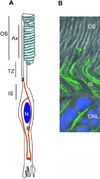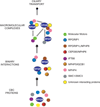RPGR-containing protein complexes in syndromic and non-syndromic retinal degeneration due to ciliary dysfunction
- PMID: 20090203
- PMCID: PMC3464916
- DOI: 10.1007/s12041-009-0061-7
RPGR-containing protein complexes in syndromic and non-syndromic retinal degeneration due to ciliary dysfunction
Abstract
Dysfunction of primary cilia due to mutations in cilia-centrosomal proteins is associated with pleiotropic disorders. The primary (or sensory) cilium of photoreceptors mediates polarized trafficking of proteins for efficient phototransduction. Retinitis pigmentosa GTPase regulator (RPGR) is a cilia-centrosomal protein mutated in >70% of X-linked RP cases and 10%-20% of simplex RP males. Accumulating evidence indicates that RPGR may facilitate the orchestration of multiple ciliary protein complexes. Disruption of these complexes due to mutations in component proteins is an underlying cause of associated photoreceptor degeneration. Here, we highlight the recent developments in understanding the mechanism of cilia-dependent photoreceptor degeneration due to mutations in RPGR and PGR-interacting proteins in severe genetic diseases, including retinitis pigmentosa, Leber congenital amaurosis (LCA), Joubert syndrome, and Senior-Loken syndrome, and explore the physiological relevance of photoreceptor ciliary protein complexes.
Figures



References
-
- Andersen JS, Wilkinson CJ, Mayor T, Mortensen P, Nigg EA, Mann M. Proteomic characterization of the human centrosome by protein correlation profiling. Nature. 2003;426:570–574. - PubMed
-
- Arts HH, Doherty D, van Beersum SE, Parisi MA, Letteboer SJ, Gorden NT, et al. Mutations in the gene encoding the basal body protein RPGRIP1L, a nephrocystin-4 interactor, cause Joubert syndrome. Nat. Genet. 2007;39:882–888. - PubMed
-
- Badano JL, Teslovich TM, Katsanis N. The centrosome in human genetic disease. Nat. Rev. Genet. 2005;6:194–205. - PubMed
-
- Bartolini F, Bhamidipati A, Thomas S, Schwahn U, Lewis SA, Cowan NJ. Functional overlap between retinitis pigmentosa 2 protein and the tubulin-specific chaperone cofactor C. J. Biol. Chem. 2002;277:14629–14634. - PubMed
Publication types
MeSH terms
Substances
Grants and funding
LinkOut - more resources
Full Text Sources
Research Materials
